《机械原理》课程PPT教学课件(Theory of Machines and Mechanisms)Chap4 Cam Mechanism
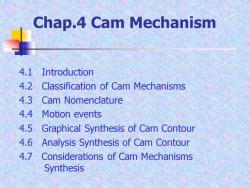
Chap.4 Cam Mechanism 4.1 Introduction 4.2 Classification of Cam Mechanisms 4.3 Cam Nomenclature 4.4 Motion events 4.5 Graphical Synthesis of Cam Contour 4.6 Analysis Synthesis of Cam Contour 4.7 Considerations of Cam Mechanisms Synthesis
Chap.4 Cam Mechanism 4.1 Introduction 4.2 Classification of Cam Mechanisms 4.3 Cam Nomenclature 4.4 Motion events 4.5 Graphical Synthesis of Cam Contour 4.6 Analysis Synthesis of Cam Contour 4.7 Considerations of Cam Mechanisms Synthesis
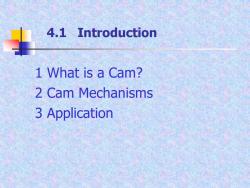
4.1 Introduction 1 What is a Cam? 2 Cam Mechanisms 3 Application
4.1 Introduction 1 What is a Cam? 2 Cam Mechanisms 3 Application
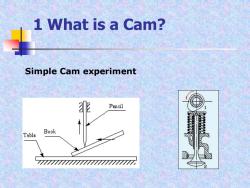
1 What is a Cam? Simple Cam experiment Pencil Book Table 77777777
1 What is a Cam? Simple Cam experiment
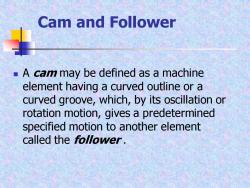
Cam and Follower A cam may be defined as a machine element having a curved outline or a curved groove,which,by its oscillation or rotation motion,gives a predetermined specified motion to another element called the follower
Cam and Follower ◼ A cam may be defined as a machine element having a curved outline or a curved groove, which, by its oscillation or rotation motion, gives a predetermined specified motion to another element called the follower
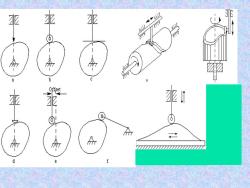
☑亚 垄 7 亚川 0 777777777777

2.Cam Mechanisms A cam mechanism usually consists of two moving elements,the cam and the follower, mounted on a fixed frame. Cam Mechanism is a mechanism which is conveniently used to transform one of the simple motions,such as rotation,into any other motions,such as translation,oscillation
2. Cam Mechanisms ◼ A cam mechanism usually consists of two moving elements, the cam and the follower, mounted on a fixed frame. ◼ Cam Mechanism is a mechanism which is conveniently used to transform one of the simple motions, such as rotation, into any other motions, such as translation, oscillation

3.Application The cam has a very important function in the operation of many classes of machines,especially those of the automatic type,such as printing presses,shoe machinery,textile machinery,gear-cutting machines,and screw machines.In any class of machinery in which automatic control and accurate timing are paramount,the cam is an indispensable part of mechanism.The possible applications of cams are unlimited,and their shapes occur in great variety. Example (video)
3. Application ◼ The cam has a very important function in the operation of many classes of machines, especially those of the automatic type, such as printing presses, shoe machinery, textile machinery, gear-cutting machines, and screw machines. In any class of machinery in which automatic control and accurate timing are paramount, the cam is an indispensable part of mechanism. The possible applications of cams are unlimited, and their shapes occur in great variety. ◼ Example (video)
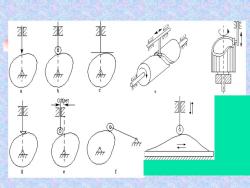
亚 4 念 亚川
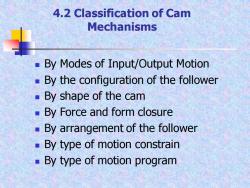
4.2 Classification of Cam Mechanisms By Modes of Input/Output Motion By the configuration of the follower By shape of the cam By Force and form closure By arrangement of the follower By type of motion constrain By type of motion program
4.2 Classification of Cam Mechanisms ◼ By Modes of Input/Output Motion ◼ By the configuration of the follower ◼ By shape of the cam ◼ By Force and form closure ◼ By arrangement of the follower ◼ By type of motion constrain ◼ By type of motion program
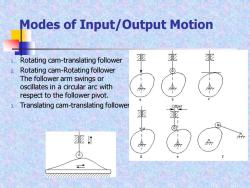
Modes of Input/Output Motion Rotating cam-translating follower 配 2. Rotating cam-Rotating follower The follower arm swings or oscillates in a circular arc with respect to the follower pivot. 3. Translating cam-translating follower 驱什 A ⑤ 土
Modes of Input/Output Motion 1. Rotating cam-translating follower 2. Rotating cam-Rotating follower The follower arm swings or oscillates in a circular arc with respect to the follower pivot. 3. Translating cam-translating follower
按次数下载不扣除下载券;
注册用户24小时内重复下载只扣除一次;
顺序:VIP每日次数-->可用次数-->下载券;
- 《机械原理》课程PPT教学课件(Theory of Machines and Mechanisms)Chap3 planar linkage.ppt
- 《机械原理》课程PPT教学课件(Theory of Machines and Mechanisms)Chap2 Kinematics fundamental.ppt
- 《机械原理》课程PPT教学课件(Theory of Machines and Mechanisms)Chap1 Theory of Machines and Mechanisms.ppt
- 《机械原理》课程教学资源(作业习题)机械原理作业(英语,无答案).doc
- 《机械原理》课程教学资源(作业习题)第十章 齿轮系及其设计(含答案).doc
- 《机械原理》课程教学资源(作业习题)第六章 机械运转与速度波动的调节(含答案).doc
- 《机械原理》课程教学资源(作业习题)第八章 凸轮机构及其设计(含答案).doc
- 《机械原理》课程教学资源(作业习题)第五章 机械的平衡(含答案).doc
- 《机械原理》课程教学资源(作业习题)第九章 齿轮机构及其设计(含答案).doc
- 《机械原理》课程教学资源(作业习题)第七章 平面连杆机构及其设计(含答案).doc
- 《机械原理》课程教学资源(作业习题)第四章 机械的效率和自锁(含答案).doc
- 《机械原理》课程教学资源(作业习题)第二章 平面机构的运动分析(含答案).doc
- 《机械原理》课程教学资源(作业习题)第三章 平面结构力分析(含答案).doc
- 《机械原理》课程教学资源(作业习题)第一章 机构的组成原理与结构分析(含答案).doc
- 新疆大学:《机械原理》课程教学资源(作业习题)机械原理各章习题集(无答案).doc
- 新疆大学:《机械原理》课程教学资源(实验指导)机械原理课程设计题目汇编.doc
- 新疆大学:《机械原理》课程教学资源(实验指导)机械原理课程设计(PPT讲稿).ppt
- 新疆大学:《机械原理》课程教学资源(实验指导)课程设计指导.doc
- 新疆大学:《机械原理》课程教学资源(实验指导)机械原理实验教程.doc
- 《机械原理》课程教学资源(教案讲义)第12章 其他常用机构.doc
- 《机械原理》课程PPT教学课件(Theory of Machines and Mechanisms)Chap5 Gear Trains.ppt
- 《机械原理》课程PPT教学课件(Theory of Machines and Mechanisms)Chap6 intermittent mechanisms.ppt
- 《机械原理》课程PPT教学课件(Theory of Machines and Mechanisms)Chap8 Application.ppt
- 《机械原理》课程PPT教学课件(Theory of Machines and Mechanisms)Chap10 Scheme of Mechanism system.ppt
- 新疆大学:《机械原理》课程教学课件(PPT讲稿)第三章 平面机构的运动分析.ppt
- 新疆大学:《机械原理》课程教学课件(PPT讲稿)第二章 机械的结构分析.ppt
- 新疆大学:《机械原理》课程教学课件(PPT讲稿)第五章 机械的效率和自锁.ppt
- 新疆大学:《机械原理》课程教学课件(PPT讲稿)第一章 绪论 Theory of Machines and Mechanisms.ppt
- 新疆大学:《机械原理》课程教学课件(PPT讲稿)第七章 机械的运动及其速度波动的调节.ppt
- 新疆大学:《机械原理》课程教学课件(PPT讲稿)第九章 凸轮机构及其设计.ppt
- 新疆大学:《机械原理》课程教学课件(PPT讲稿)第八章 平面连杆机构及其设计(1/2).ppt
- 新疆大学:《机械原理》课程教学课件(PPT讲稿)第八章 平面连杆机构及其设计(2/2).ppt
- 新疆大学:《机械原理》课程教学课件(PPT讲稿)第六章 机械地平衡.ppt
- 新疆大学:《机械原理》课程教学课件(PPT讲稿)第十一章 齿轮系及其设计.ppt
- 新疆大学:《机械原理》课程教学课件(PPT讲稿)第十二章 其他常用机构.ppt
- 新疆大学:《机械原理》课程教学课件(PPT讲稿)第十四章 机械系统的方案设计.ppt
- 新疆大学:《机械原理》课程教学课件(PPT讲稿)第十章 齿轮机构.ppt
- 新疆大学:《机械原理》课程教学课件(PPT讲稿)第四章 平面机构的力分析.ppt
- 《机械制造技术基础》课程教学资源(教案讲义)第三章 金属切削机床.doc
- 《机械制造技术基础》课程教学资源(教案讲义)第五章 机械加工质量及其控制.doc
